Martin Greenough died on December 12th 2015 after being hit by a reckless driver on NE Lombard. Greenough was struck in a notoriously dangerous spot where the road narrows and the bike lane abruptly disappears — forcing bicycle users to share a lane with vehicles that regularly travel 50 mph.
In light of Greenough’s death, the Oregon Department of Transportation will fill that deadly bike lane gap.
By this summer (at the latest) there will be a new bike path in the eastbound direction of NE Lombard Street where it goes under NE 42nd Avenue. According to ODOT the path will be 450-feet long and six-feet wide. It will be constructed off the highway and will go behind existing guardrails and columns that support an overpass. Here’s the official statement from ODOT:
We will be starting construction this winter on a new, 450-foot off-street bike lane in the eastbound direction of NE Lombard Street (US 30 Bypass) under the NE 42nd Avenue bridge. Construction should be finished in spring 2017.*
The space under the NE 42nd Avenue bridge is narrow and currently the bike lanes on NE Lombard are not continuous under the bridge. The space is limited because it is next to the railroad line on one side and the bridge piers can’t be moved.
Since a fatal crash involving a bicyclist in December 2015, we have been working hard to gure out how to increase bicycle safety in this space- constrained area. The project will build a new 450-foot long, 6-foot wide bike lane off the roadway, in the eastbound direction on NE Lombard Street. The lane will be located behind a barrier that also protects the bridge piers from being hit by a vehicle. We will also install new signage for the eastbound bike path.
This same gap in the bike lane exists in the westbound direction as well. I’ve asked ODOT why they aren’t planning to do anything in that direction (I’ll update this story when I hear back). UPDATE: ODOT says they lack right-of-way on the other side of the street. There’s a freight railroad there.
I observed the area closely right after the collision.
Here’s an approximate location where the bike lane will leave the roadway and go behind the barriers…
Advertisement
The view from under the overpass. The new path will go to the left of the barricades…
Here’s a view taken from the overpass. The new bike path will be to the left of that barricade (not the end of the bike path near the truck’s front wheel)…
Not only is this gap unacceptable and dangerous by design, but the agency knew about it beforehand and took no action. ODOT was under a lot of pressure to do something. Then Bicycle Transportation Alliance Executive Director Rob Sadowsky said at the time that, “I think a protected bike lane would have saved this person’s life.”
After this preventable tragedy, ODOT promised to analyze this section of road and try to do something. But they always say that, and I was starting to think it was just another stall tactic to make activists go away. It’s ironic that I heard about this project only after I asked them whatever came of that analysis.
Suffice it to say I am very pleasantly surprised to learn about this. It shows ODOT is willing to learn from mistakes and try to do better.
That being said, we should never forget why this path was created. Martin Greenough unwillingly gave his life for 450-feet of bike path. And if it was there on that fateful night, he’d still be alive.
— Jonathan Maus: (503) 706-8804, @jonathan_maus on Twitter and jonathan@bikeportland.org
BikePortland is supported by the community (that means you!). Please become a subscriber or make a donation today.



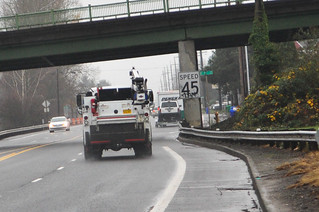
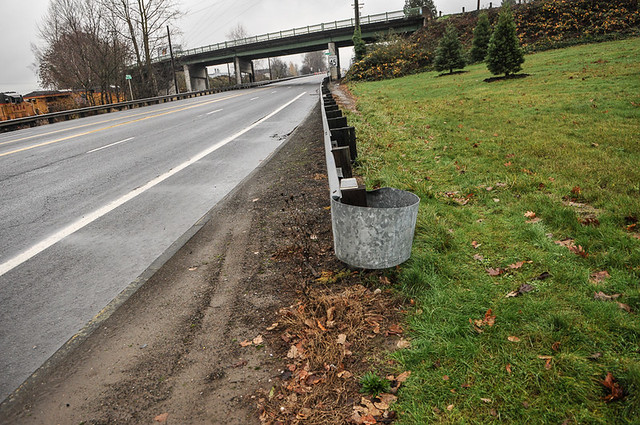
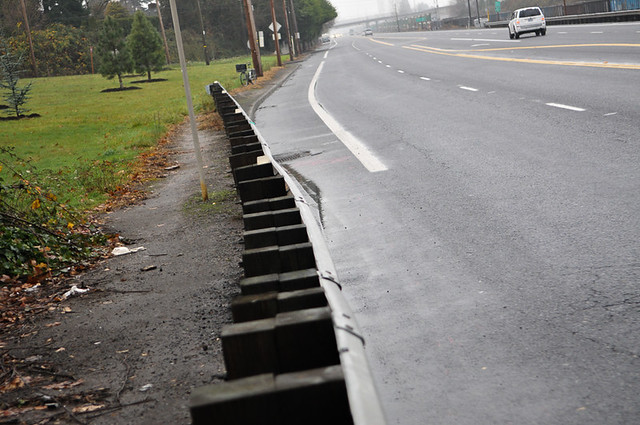
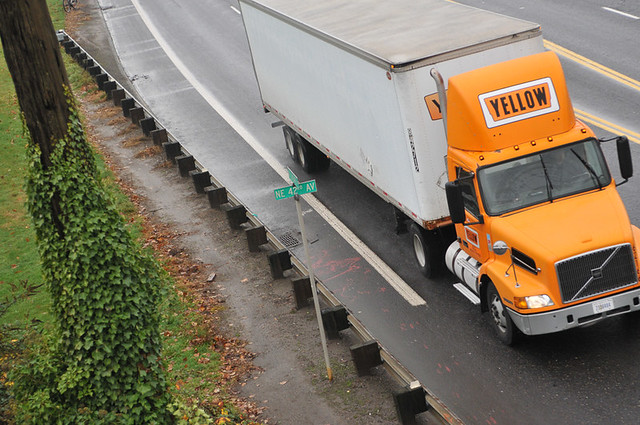
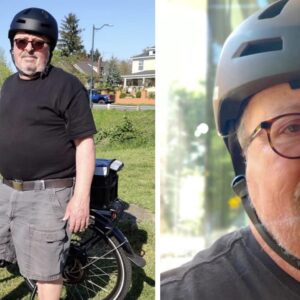
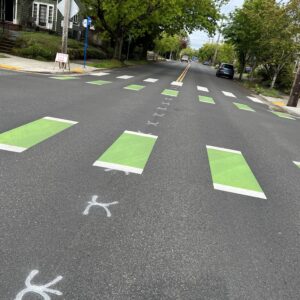
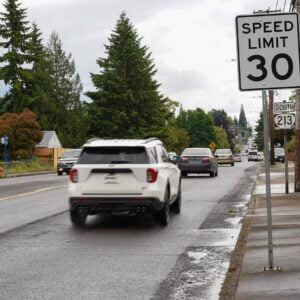
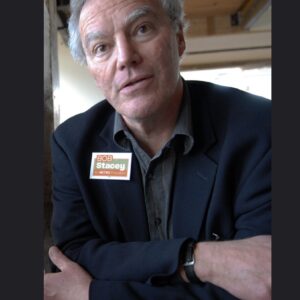
Thanks for reading.
BikePortland has served this community with independent community journalism since 2005. We rely on subscriptions from readers like you to survive. Your financial support is vital in keeping this valuable resource alive and well.
Please subscribe today to strengthen and expand our work.
Any plans for a protected path on the north side of Lombard?
Indeed, the situation looks identical on the north side. I didn’t see any reply to this question. In some ways it looks cheaper (no need to retain the earth as on the south) assuming there is six feet in the right of way north of the bridge supports. Jonathan, is this part of the ODOT project?
So, OK, I’m blind. You (Jonathan) mention this in the article. Streetview shows a sizable asphalt apron behind the guardrail and bridge pier, paved along with the highway it would seem, suggesting it is ODOT land. It might not be six feet. Personally I’d rather see a slightly narrower bike solution westbound than a shrug of the shoulders. Other options might include blinking lights triggered by bikes passing in the bike lane, clear signage for cyclists about the hazard, narrowing of the main travel lanes, etc. etc. Something, anything.
Something is better than nothing. To what degree the suggestion you’re venturing to offer, could mean increased protection against road users that are DUI, as the person driving his motor vehicle into Martin Greenough on his bike was…is difficult to say.
It’s difficult to expect much protection from such measures against DUI road users, given that it’s common that such people often have trouble keeping their vehicle on the road, and from hitting people and things.
ODOT does what we, the taxpayers, people that are the public, pay them to do. Give the dept the money to do it with, and they’ll build us anything we want.
Have the people that are the public, as a whole rather than a comparatively small percent of the public, really been asking the dept through their elected officials, to go ahead and spend whatever it takes to make all bike lanes continuous where they currently exist in only segments involving transitions by people biking into main lanes of the road?
Something is better than nothing. Where it comes to assigning responsibility for what is done and what isn’t, it’s best to assign that responsibility where it correctly belongs.
If you look at the street view, there is a second column wall next to the tracks. seems like a bike lane could fit between the columns (not a train). The cost to build wall and fill may be the issue.
I mostly agree, but can we please stop normalizing blinking lights as a safety solution? Blinking lights are a driver convenience solution. They let the DOT say “hey, we did a thing,” without slowing traffic or reallocating road space. The only light that seems to provide even a semblance of protection is a red one.
Speaking about traffic fatalities, whatever happened to Abdulrahman Noorah? Have not seen anything about his trial etc. since last fall.
It is bizarre, he bailed out and then disappeared. I can’t find any information about an upcoming court date. I wouldn’t be surprised if he managed to leave the country, but you’d think that would be a story someone would be reporting on if he did.
The following are on the court schedule in the next 90 days:
Case Number: 16CR52157
Type: Offense Felony
Style: State of Oregon vs Abdulrahamn Sameer Noorah
Judicial Officer: Walker, Kenneth R
Physical Location: Courtroom 608
Date: 02/23/2017
Time: 9:00 AM
Hearing Type: Hearing – Settlement Conference
Case Number: 16CR52157
Type: Offense Felony
Style: State of Oregon vs Abdulrahamn Sameer Noorah
Judicial Officer: Waller, Nan G
Physical Location: Courtroom 208
Date: 02/24/2017
Time: 9:00 AM
Hearing Type: Call – Regular
It appears the case is proceeding.
Thanks Stephen!
“The space is limited because it is next to the railroad line on one side and the bridge piers can’t be moved.”
let me fix that for them to make it more true of their motives…
“The space is limited because we refuse to take space from motor vehicles in the name of safety.”
“protects the bridge piers from being hit by a vehicle”
another quick fix… because we all know the real problem…
“protects the bridge piers from being hit by a motor vehicle”
If only lives (of vulnerable users) were as valuable as bridge parts. The guardrails on the sw barbur viaducts wouldn’t take up as much of the sidewalk.
How about a bike path along the railroad line?
rail bike http://www.bikehacks.com/bikehacks/2012/04/rail-bike.html
Brumotti doesn’t need such dangerous contraptions.
Railway rights of way are complicated legal waters to navigate. I can see why ODOT would say “they lack right-of-way on the other side of the street. There’s a freight railroad there.” That doesn’t mean a bike way cannot be placed there, but it must be negotiated with the particular railroad that owns the right of way. Ownership and maintenance may also be complicated by the rail right of way. Perhaps the Rails-to-Trails Conservancy can help. I don’t know how to contact them for this sort of thing. Does anyone here have experience?
Stph
I hope ODoT design team would consider :
1) placing an effective buffer separation of the future bikeway and the industrial highway (taking into account the distance wet road spray/ wind buffeting from trucks) where possible, this may also include a short section of plexiglass divider under the overcrossing; and
2) considers adding a bicyclist “rest area” in this underutilize open space(s).
Amanda’s husband Steve Fritz was driving a car when he was killed. Only took a month for ODOT to find $7M to extend the median cable barriers up I-5; Martin Greenough, of course, was not driving a car, so it takes ODOT 15 months to find the wherewithal to address the problem (that I’m quite sure won’t cost anywhere near $7M).
Better late than never, though.
Personally, I’m glad they added the barriers so that more people don’t get killed.
That wasn’t my point. It was the all too predictable asymmetry, auto prioritization, and foot dragging when it comes to non-auto modes we’ve come to expect from ODOT.
Of course there was. They also probably had a design ready to go for I-5, whereas they likely had to start from the beginning with this project.
my point. = cars über alles.
Actually, it’s freight über alles.
A convenient excuse, but really it’s about cars. Otherwise they would make a better effort to get all of these cars out of the way of the freight. There’s a truck lane on I5 northbound from Tigard which I’m pretty sure is all about getting freight out of the way of cars.
It’s not about overhead clearance (Streetview doesn’t show any warning signs on the overpasses).
This truck lane occurs at the first opportunity for vehicles driving northbound on 99W to change over to I-5. Thus traffic is heavy, and the ramp descends from 99W to I-5, so it is accelerating as well. The truck lane puts slow trucks climbing the incline on I-5 to the right of the fast traffic merging onto I-5; otherwise, you would have heavy, fast traffic merging across a lane of slow, climbing trucks. It wouldn’t surprise me if the lane got built after a history of merging accidents.
So it is about getting trucks out of the way of cars, in a sense, though at least partially for legitimate safety concerns.
Nice kitty…peerrfeect turn of the phrase.
“freight über alles”
Hardly. My kind of freight, the bicycle-delivered kind, doesn’t even register with ODOT.
“freight über alles”
Hardly. My kind of freight, the bicycle-delivered kind, doesn’t even register with ODOT.
How did uber get dragged into this?
Did you miss the Umlaut?
Um, not a laut.
Wenns denn sein muß.
Your iPhone has to get into your hands somehow.
I got mine at the Apple store. I went there by bike.
Considering how many more cars travel on I-5 than bikes travel on Lombard, it’s not difficult to understand why the car-related project might take precedence.
Classic.
Most folks in Oregon are heterosexual Caucasians. Does that in your view mean that everyone else should just take what is left over, and be thankful?
I think what it means is that if you have a finite budget for safety, it makes sense to spend it in ways that will maximize lives saved and injuries prevented. This is neither an irrational nor an immoral approach.
It’s been a while since I looked into this, but I recall that most guard rails no longer discriminate based on race or sexual orientation, so I think we have those bases covered. But thanks for bringing it up.
“spend it in ways that will maximize lives saved and injuries prevented.”
Except that the idea that Garrett’s appropriation of funds for the wires up the median of I5 meets this test is pure speculation on your part. We have no idea if, dollar for dollar, those $7M spent on the wires in the I5 median will save more lives than, say, spending it on enforcing the cell phone law or the too fast for conditions law. The people driving on I5, generally speaking, are pretty well protected by their vehicles and the width of the lanes, etc. The people biking and walking in Portland, not so much.
You’re right… I have the same data you do, but I do have some insight into the minds of engineers. Mine is a far more likely explanation than the “Fritz pulled strings” theory (which makes no sense on its face — not only is Fritz not a power broker in Salem, this project in no way benefits her; it only helps the next potential victim).
If a car veers across the median and hits you head-on at 50MPH, your vehicle will not afford you much protection at all. I’d bet almost anything that a proper evaluation of the I-5 project and the Lombard project would show a far larger safety improvement for the I-5 project. I’d also be willing to bet that the Lombard project was more influenced by “non-data factors” than was the I-5 project. Maybe Fritz used her influence to push that project forward as well?
As the person who brought up the Fritz crash, ‘m happy to note that I never suggested or implied that his wife ‘pulled strings.’ Car Head works without any such power plays; it is a far more pervasive element of how power and priority works in our society.
The crash was far more visible and embarrassing to ODOT because of the connection to one of the better known politicians in our state. That is more than enough in my view. The fact that there were lawsuits which I wasn’t aware of only heightens ODOT’s interest (and undermines any string-pulling nonsense).
I guess I’m not sure what you’re unhappy about.
Do you disagree that the guard rail is likely to protect future drivers? Do you think that money would be more protective if spent on other projects? Do you disagree with the whole concept of prioritizing safety spending where it will have the greatest impact? Do you just think “car people” don’t deserve safety?
If we could establish, with data, that the I-5 project would protect more people than using the same amount of money to fix dangerous underpasses, would that satisfy you?
I’m unhappy about commenters’ facile and glib endorsement of priorities that to me look like classic CarHead.
“Do you disagree that the guard rail is likely to protect future drivers?”
No. But the framing is foolish and limited. If we were really interested in that, lowering the speed limit would be (a) free, and (b) far more effective. There are hundreds of other examples one could marshal.
“Do you think that money would be more protective if spent on other projects?”
Yes, dozens, hundreds of other free projects, see above.
“Do you disagree with the whole concept of prioritizing safety spending where it will have the greatest impact?”
No. I disagree with foolish statements to that effect that are meant to justify projects that are SOP rather than actually useful.
“Do you just think “car people” don’t deserve safety?”
See above.
If we could establish, with data, that the I-5 project would protect more people than using the same amount of money to fix dangerous underpasses, would that satisfy you?”
Lowering the speed limit would work, if people adhered to it. Of course a 35 MPH freeway does not serve it’s primary purpose as well. Using that same logic, we could fix the Lombard underpass much cheaper by simply closing it to motor vehicle traffic. Why are we wasting our money when we have that free and more effective solution at hand?
“Why are we wasting our money when we have that free and more effective solution at hand?”
You tell me. You’re the one who started the $/life modal efficacy comparison.
Many commentors disagree with your use of “CarHead”.
That assertion doesn’t amount to much of a disagreement. Would you care to articulate what those commenters disagree about it? Jonathan doesn’t like the sound of it, but I don’t think he disagrees that it is real.
Or that fact that one was the husband of a well connected, high ranking city official, and the other was a guy who was new to town?
Sure. But at the end of the day I think it mattered that he was driving in a car and the kind of solution they found the money for fit how ODOT sees its mission. As others have noted, median cables on I5 are SOP, they just had to appropriate the money. Fixing screwy infrastructure for those scruffy bikers isn’t something they are used to, know how to do very well, can make happen quickly or graciously.
But the real turn of the knife is that they seem either clueless or disinterested in the fact that those of us who bike are also a constituency who pays their wages and buys their equipment and are deserving of equal consideration and remedy.
If Fritz threw her considerable political weight around in Salem to get a significant safety enhancement installed on I-5, then I for one thank her for the lives she saved.
It gets even more interesting. I just learned (I don’t read the Oregonian) that –
“the state of Oregon agreed to pay Fritz’s estate $1.45 million to settle a claim that the Department of Transportation was at fault for failing to build a possibly life-saving median barrier on that stretch of I-5”
http://www.oregonlive.com/portland/index.ssf/2016/05/i-5_death_of_amanda_fritzs_hus.html
I wonder if Martin Greenough’s family sued ODOT? I’m willing to speculate that if they had, Car Head would not have likely given them the same treatment, chances of winning a settlement, etc.
It is also worth noting that Amanda Fritz didn’t sue ODOT, but the person driving the pickup and who killed her husband did. Even more remarkable to see that settlement if you ask me.
http://www.oregonlive.com/portland/index.ssf/2015/09/driver_who_struck_killed_amand.html
Yes. The Greenough family has a pending lawsuit with the City of Portland and with ODOT. I am in touch with their lawyer and will be covering it as developments happen.
http://bikeportland.org/2016/04/21/city-state-sued-over-death-of-martin-greenough-181396
Circumstances of the collision on I-5 in which Fritz’s husband died, and the collision on Lombard in which Martin Greenough died, are very different from each other. One of the
differences, was that it’s likely that none of the three people driving in the I-5 collision were DUI. Many other important differences as well.
The O did a number of stories on that collision, the suit and settlement. A bunch of research and interviewing went into them it seems. One of those stories explores how it came to be that ODOT(in the story, look for “decentralized structure”) didn’t install the median cable barrier sooner than it did, is accessible by this link:
http://www.oregonlive.com/commuting/index.ssf/2014/10/steve_fritz_oregon_i-5_salem_c.html
“we should never forget why this path was created”
they should put up a plaque to honor him…
surprised there’s no ghost bike here…
“…should put up a plaque to honor [Martin]…”
That is a good idea! Does anyone know if there is a process for that?
Stph
Short though it will be, perhaps it should be named “The Martin Greenough Bike Lane” or some such and have a giant road sign informing traffic that it is coming up. The sign could have a white bike emblem on a green background to represent, subtly, a ghost bike.
The design described above is the obvious one; I am very curious what they say about doing something similar in the opposite direction.
There are grade (and probably right-of-way) issues on the north side that I suspect will complicate the design of a separated path. Hopefully, they’ll do something similar eventually, and it won’t require another human sacrifice to bring about. I hate the fact that our planning process is so reactionary. The entire corridor should have separated cycling facilities and barriers between the two directions of motor vehicle traffic, due to the high speeds allowed there. It’s a poor design all around. Like most of our roads it was simply built rather than thoughtfully designed.
Stph
Grade, probably. Right of way, I don’t think is a problem. Looking at the aerial imagery, you can draw a straight line from the road right of way on either side of the 42nd overpass and see there looks to be enough space on the north side. (Presumably the RR ROW doesn’t take a sudden bend, but follows the same straight line.)
Looks like it would involve a break in the barrier, and whatever the grade issues are (I’m not that familiar).
The guard rail needs to be moved toward the through lane all the way on the north side, where the 30 mph+ limit exists. The guard rail is a lot longer on the north side. There is also approximately 30 feet of space between the posts/guard rail on the north side and the tracks. I don’t know of any rail devices that would be in interference.
“…Like most of our roads it was simply built rather than thoughtfully designed.” keller
I doubt the designers of the road are responsible for not having provided continuous bike lanes when the road was built. Lombard isn’t a new road…it’s old. I’m sure the roads were thoughtfully designed for the era they were designed and built in. The shortcoming of those designs that become apparent today, comes from the fact that very many of roads in city and the state, were built in an era when people in ever increasing numbers, were choosing motor vehicle travel over biking…if in fact, very many people in the mid to earlier decades of the last century, did use bikes for travel in our area.
Oregon has been retrofitting old, existing roads for bike lanes, for more than fifty years. And building new roads that include bike lanes. It costs a lot of money to do this, and when it’s said and done, it still largely leaves the question of ‘Who is going to ride them?’.
Continuation of the bike lanes under the overpass, is a minor improvement relative to the overall safe usability of biking on Lombard, consisting isn’t it?…of bike lanes that are immediately adjacent to the main lanes of the road…which, except for the determined and desperate riders, most people won’t even consider riding.
I’m sure East Lombard was thoughtfully designed for the age it was originally built, but I also expect it started out life as a two-lane road. The expansion to four lanes was probably not as well thought through.
Looking at the pictures, it’s almost unbelievable they didn’t do this before. The bike lane practically draws itself on the right side of the support beam.
It does seem obvious looking at the photo–also obvious how dangerous the current design is. From what I’ve seen on some other projects, things like bike lanes sometimes seem to be just lines on a drawing done by some CAD operator without any real consideration of the ramifications in real life.
Here it looks like some drafter got told to add a bike lane on a drawing, so he or she drew the line on the plan, kept going until there wasn’t enough width to keep going, so then just stopped the line and ran a plot, and marked “4 hours on job X” on their time card. Then their job was over, and some guy in the field painted a line where the drawing said to paint it. Nobody actually took responsibility or initiative to think “this dumps cyclists right into traffic and is going to kill someone someday” and do anything about it.
There are hundreds of examples like this all over town. It’s also as if nobody involved in the projects ever even comes and looks at the lines on the pavement after they’re painted–they’ve already moved on to drafting lines on other drawings.
There are other ramifications to this proposal, such as maintenance of something that street sweepers can’t get to, and the grade projection of the embankment under the bridge. They will likely need to build a beefy retaining wall to conform with engineering specs needed to hold the bridge up (based on soil testing), and during rain and wind there may still be scree-fall coming down into the bike lane.
Easy answer (that DOT will not consider without a lot more pressure from the public): Neck the car lanes down to one lane an move the guard rail out 8 feet for a nice wide bicycle passage. Done and world class… but no… taking absolute priority away from cars DOT will not do .. yet.
I know figs are out of season, but this quote is missing one: “to gure out how “.
So sad that so many times we get safety improvements only in response to someone being killed. And so often these are places with known safety problems that the community was raising a stink about (42nd/Hawthorne, Barbur rapid-flash beacons, you name it), but nothing happens until someone dies.
While the path is welcome, I think some perspective is useful. Despite this specific section being dodgy, I’ve always regarded this area of being relatively safe compared to others of Lombard which have no bike lane whatsoever and butt up directly into a curb.
Lombard, at one time, had bike lanes or fog lines with space, the full length from east of MLK/Union through St Johns. They disappeared in about 1965 when Lombard went to 4 lanes from 3 and 2 with parking west of Columbia park. I know because I started riding it in 1953. BTW I rode behind the 42nd pillars then, because there was no guard rails to keep the cyclist out of the path.
its going to take a lot of dead bodies to build out our network 450 feet at a time.
“its going to take a lot of dead bodies to build out our network 450 feet at a time.”
My vote for quote of the week.
What a horrifying thought. I bike through gaps on Barbur everyday. I hope that it doesn’t take more deaths to take care of them. I think Barbur is another ODOT street? It’s a shame they’re in charge of so much while being so removed from local issues.
Glad to see this. Should have been done long ago. The other direction should be done too. The design of the bike detour path is very simple. You can see from the photos that pedestrians have been walking that exact same path all along. It didn’t take ODOT 15 months to “figure out” this solution. It took them 14 months to decide that they cared enough to do something, and 1 month to realize that whereever a pedestrian can walk, a cyclist can ride. As for the cost, maybe they will lay on lots of overhead cost allocation, but in direct costs basically we’re talking a few hundred feet of asphalt path, which will be a rounding error in ODOT’s budget.
Why not just put the entire length (between lights) on a road diet, install a jersey barrier and have a 2-way protected bike path on the north side? Given the presence of the railroad, there are very few points of conflict.
You forgot the basic operating tenet of ODOT: cars and freight first, last and always.
You’re suggesting creating a slight (and likely temporary, considering induced demand) inconvenience for motor vehicles solely to save lives and make cycling more attractive. That’s not the world ODOT lives in, though it is the one many of us would like to inhabit.
Our mere 56% rise in annual roadway death since 2013 seems to not have ODOT’s attention.
2005 peak hours exceed 1400 vehicles per hour. 1000 vph per lane is the standard rule of thumb, so 2 lanes each direction is recommended.
based on 12 year old numbers though.
Is that the rule even with no traffic signals? I’ve driven this stretch so many times, and I can’t imagine how a merge and a single lane for the un-signalized section would have ever slowed me down. What are the traffic counts for NE Glisan between 60th and 82nd? They just have one lane in that stretch.
It’s fine that a continuation of the bike lane can be provided behind the columns of the overpass, rather than not having any bike lane at all under the overpass. This generally will be an improvement to the safety of using this road by people biking on it.
Nevertheless, people ought not to quite so certain that a continuous bike lane would have prevented the collision Martin Greenough was a victim of, likely due in large part to the fact that the person driving the motor vehicle, was found to be very intoxicated with marijuana at the time of the collision.
Intoxicated as he was, why might have the driver of the motor vehicle failed to keep from running into Greenough, likely riding his bike to the far right of the main lane as it travels under the overpass? Nearly all the bike lanes in Oregon, are directly adjacent to the main lanes of the road.
People generally can ride successfully on such bike lanes or even narrower road shoulders, because most people that drive are able to be relied upon to consistently keep their vehicle from veering off the main lane of the road and onto the shoulder or adjacent bike lane, especially when someone is riding a bike there. When people driving, are DUI, all bets are off. Any certainty that a DUI person driving can be relied upon to not run into someone riding a bike on the road…or walking, skateboarding, or driving…diminishes dramatically.
Glad to read that this improvement for biking on Lombard is being made, but more lives will likely be saved by being careful to accurately determine the causes of collisions when that is possible.
Do you not agree that a forced proximity to the car’s travel lane – and thus significantly increased reliance on the speed and attentiveness of the driver – was a contributing factor here? My neighbor Stan was killed while riding to the right of a very wide bike lane, but witnesses testified that his murderer had veered significantly out of her lane of travel while she was looking down at the cell phone on which she was replying to a text. Now that is a situation where the contributing factors were mostly under the driver’s responsibility, and not that of a tail light or reflector or high-vis vest or painted bike buffers or physical protection, etc.
One item of due diligence you citizens will need to be concerned with is maintenance of the proposed path separation. In the current configuration I’d assume sweeping of the travel lane is done, but in the bypass you’ll need to make sure they design for – and comply with – regular cleanup by Portland’s bike lane sweepers.
I argue that if Martin was riding in the proposed configuration, he’d have been far less likely to have been hit.
Of course, due to the merge of the bike lane into the main lane as it approaches the underpass, closer proximity of the motor vehicle to bike traffic, becomes a somewhat greater potential contributor to collisions than does proximity associated with main lanes having bike lanes adjacent to them.
Not than much of a factor though, I’m afraid. I’ve thought about this a lot, believe me. Particularly with in mind, the seemingly immense assurance some people that ride, seem to have in the superficial safety that main lane adjacent bike lanes can offer. I mean…it’s not like the painted demarcation line between bike lane and main lane, is a force field, or a shield like in sci-fi.
Anybody at any time, with just a slight flick of the steering wheel, can drive right over that line and crash into whatever might be there.
This happens as little as it does, I think, because most of the people driving are reasonably capable drivers with a conscience and moral values. And then there are the numerous number of people representing a completely mixed bag of disaster just waiting to happen. What to do to reduce their number? How to find out who they even are before their ineptness or homicidal inclinations cause a tragedy?
If the person driving a motor vehicle in the main lane of the road, approaching Martin Greenough from behind as he rode his bike to the right of that lane…had been sober, reasonably well rested, and non-distracted, Martin most likely would have continued to proceed on his way unscathed. This because even on fairly narrow roadways, most people driving are able to successfully keep their vehicle distanced away from people riding bikes parallel to them in the very same lane.
We can be glad ODOT is arranging to construct this continuation of the bike lanes located behind the support columns of the overpass. Unlikely though, that the dept would be able on this kind of schedule with the money it has, to eliminate a whole bunch more similarly hairy infrastructure situations in Portland and other Oregon cities.
And regular maintenance? I don’t mean to laugh…but that’s funny, coming after the two big snow storms we’ve had this month…with tons of tire flatting, balance throwing gravel still remaining on the asphalt for likely days, and even weeks to come. Much easier to put the stuff down than it is to pick it back up off the street.
Look at this image. I bet few riders on this forum would say with confidence that if they were riding on this road at night for one of their first times, that they would have noticed or even seen this sign with their lights: https://goo.gl/maps/LXQypLYmrJD2. And that also depends on bike speed…
“If the person driving a motor vehicle in the main lane of the road, approaching Martin Greenough from behind as he rode his bike to the right of that lane…had been sober, reasonably well rested, and non-distracted, Martin most likely would have continued to proceed on his way unscathed.”
Once again we disagree on our speculations. I submit that at 45 MPH one could easily overrun their headlight distance upon a bicyclist with the Oregon-regulated taillight, and the trajectory of cars at that speed is straight, not swerving slightly left as the dotted line indicates – striping like this is ludicrous.
ORS says 600′ visibility from reflector, but even a strong taillight is marginally visible at that distance, and research says low beams are good for ~200′-400′ at best:
http://www.iihs.org/iihs/sr/statusreport/article/51/3/1
http://www.lrc.rpi.edu/programs/transportation/pdf/NITSA/FarberNHTSAworkshop.pdf
As the study notes, low beams are meant for lane compliance, and moving the bicyclist unexpectedly closer to the right of the first travel lane – while expecting the driver to even notice let alone comply with the slight jog left – puts them at risk of being clipped by an attentive driver at speed on this road, let alone one that’s tired or high.
“This because even on fairly narrow roadways, most people driving are able to successfully keep their vehicle distanced away from people riding bikes parallel to them in the very same lane.”
Most people driving – high, attentive, whatever – endeavor to keep their cars centered within the lines, and along a relatively straight trajectory. Just scout around the Google imagery here – the bike lane literally disappears! Imagining the car as a 9′ wide rock from a slingshot launched center-lane before the jog left, and I am (sadly) not surprised a ~3′ wide cyclist got clipped here.
the poor road planning was only part of the problem. The offending driver was HIGH on pot at the time of incident.
Sounds like something that’s not ODOT’s responsibility to address. What’s your solution? Or are you just pointing fingers at a non-human entity and calling it evil?
Vision Zero (which was conceived by Sweden’s version of ODOT) takes a comprehensive look at human fallibility and explores what solutions across a variety of dimensions would look like and how to implement them. I didn’t take what SE Rider was saying as blaming ODOT at all, though I recognize the possibility (however remote it seems from here) that an agency like ODOT could embrace something like Vision Zero and accomplish great things.
Of course the distance between our actual ODOT and what a potential agency could proactively do speaks volumes.
Good summation. I also didn’t read it as a criticism of ODOT. And you’re right about the rest, too. As the Vision Zero video in another recent article here said, roads should be designed with the assumption that there WILL be bad driving, intoxication, etc. happening. Someone riding a bike on the other side of a barrier wouldn’t have been hit.
I asked for clarification because, to me, the comment seemed to lay blame at the feet of the intoxicating substance. While I appreciate the sentiment that engineering can help improve the safety of road users, it cannot address irresponsible decisions that individuals make. I certainly was not poking a bee’s hive about the efficacy of Vision Zero, but thanks for taking advantage of this opportunity to do so.
“While I appreciate the sentiment that engineering can help improve the safety of road users, it cannot address irresponsible decisions that individuals make. ”
I think, strictly speaking, that this is not true. I think I learned this from the folks who came up with Vision Zero.
That road conditions for biking in Oregon, are less than what probably many people would like, does not mean that ODOT personnel aren’t interested in ideas the dept could be enlisted help put in place means that would work for the elimination of all traffic related injury and deaths.
Have the public, through their legislators and government personnel, give them instructions for vision zero inspired projects, and the money to follow through with them, and the dept most likely would do so. Has ODOT been given this type instructions for any such projects?
>>> the poor road planning was only part of the problem. The offending driver was HIGH on pot at the time of incident. <<<
I'll bet ODOT sold him the weed.
You gotta pay for the roads somehow.
ODOT: We know you are dying to bring us new ideas. Don’t delay!
ODOT: People are literally dying for you to bring us new ideas. Don’t delay!
Glad to hear this. That’s the worst part of my daily commute.
Do you work in the nearby industrial area? Do you ride through to connect to nearby greenways?
“Martin Greenough unwillingly gave his life for 450-feet of bike path.”
Absolutely, and you should heretofore refer to this project as the “Martin Greenough Memorial Bypass”, especially in your conversations with officials. I can tell you the folks at Santa Clara County aren’t happy to hear me repeatedly refer to their proposed ‘improvement’ at Page Mill and I-280 as “The Jeff Donnelly Memorial Greening”, but they get the point.
https://bikesiliconvalley.org/2016/07/page-mill-interim-design-ready-next-phase/
Keeping in mind that it was a DUI marijuana driver apparently unable to keep his vehicle in a straight line, or put on the brakes and stop, and instead, according to his comments reported in the news, veered to the right and into Martin Greenough on his bike as he was riding on the right side of the lane through the underpass.
The guy driving said he veered to the right because he thought someone from the opposite direction was coming straight towards him. Maybe the underpass redesign should be referred to as anti-pothead collision infrastructure.
The driver was high on weed, but BikePortland seems intent on suppressing that fact.
Many car crashes have taken place with drivers under the influence of that drug. Very sad. Oregon is a state that celebrates drugs and alcohol.
Can you give examples of how the state celebrates drugs and alcohol?
If you run someone over who is standing in the road and you are high/drunk, you WILL get in trouble for it. If you run someone over who is standing in the road and you are NOT high/drunk, you will probably NOT get in trouble for it.
How much does it matter whether he was? The victim is just as dead as if the driver had been sober. And it’s not like that driver was the last that will drive high, drunk, texting, speeding, unable to see in the dark, driving with bald tires…Part of road design is to protect people from bad driving.
“How much does it matter whether he was? …” q
How much does it matter that the person driving was DUI? If you’re seriously interested in the answer to that question, search and go back through the stories written in the Oregonian and bikeportland, about this collision and the trial afterwords.
By those sources of info, which include some statements made by the person driving, the guy driving wasn’t someone that had just had one joint, a beer, a drink. He apparently was very intoxicated, and was incapable of competently responding to visual stimuli required to safely drive a motor vehicle.
Becoming aware of a motor vehicle approaching from the opposite direction, he claims he believed it was coming straight at him, so he slams into Martin Greenough on his bike, to his right.Was a motor vehicle really coming straight at him from the other direction? Anyone’s guess I suppose, unless there were witnesses, or he had a dash cam. If he’d been sober, his story might be somewhat believable…but lacking that, his story is very doubtful. He was unable to safely operate his vehicle.
If having completely irresponsibly crashed into somebody while intoxicated, wasn’t outrageous enough…he doesn’t stop after crashing into a guy on his bike(claims he didn’t realize that what smashed up against his windshield was a person.)…continues on home. It’s some kind of miracle this seemingly entirely self absorbed person was even tracked down, cited and convicted. A statement of his before the court objecting to the sentence he was given, left the impression that he felt unfairly put upon for it’s degree of severity.
It’s very important to not be DUI while driving on the road, and really…that goes for riding too, whether it be by bicycle, motorcycle, or scooter. Not such a good idea while walking, either.
wsbob–that’s all interesting, but…so what? He’s not the first intoxicated, distracted, or careless driver and he won’t be the last. If the street had been properly designed, he wouldn’t have hit the cyclist. As it was, the street design made it almost inevitable that a cyclist would be hit eventually, and it wouldn’t require that the driver be anywhere near as compromised as that one apparently was. A driver being distracted for a second at the right instant would be enough to kill a cyclist with that design.
And yes, “It’s very important to not be DUI while driving on the road, and really…that goes for riding too…” but I think we all realize that.
>>> BikePortland seems intent on suppressing that fact. <<<
I'll bet the only reason you know the driver was high was that you read it on BikePortland. I don't think that information was "suppressed".
No, not really.
Since we are giving up on enforcement, shouldn’t speed limits take into account the reaction times of someone smoking pot. While drunk drivets would need a limit of 0mph, pot smokers might only need 5 on 10mph less than the curent limit. I don’t know if this characterization might already exist.
Still only in one direction?